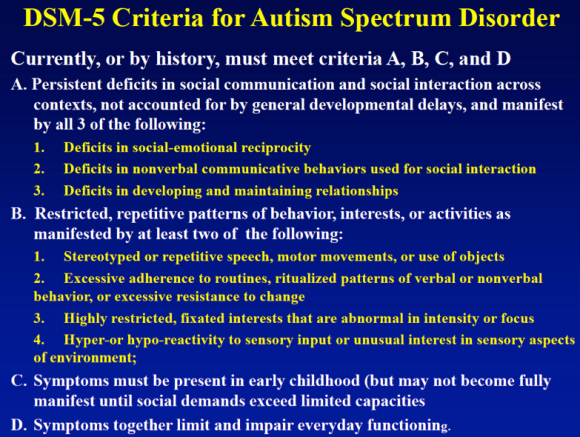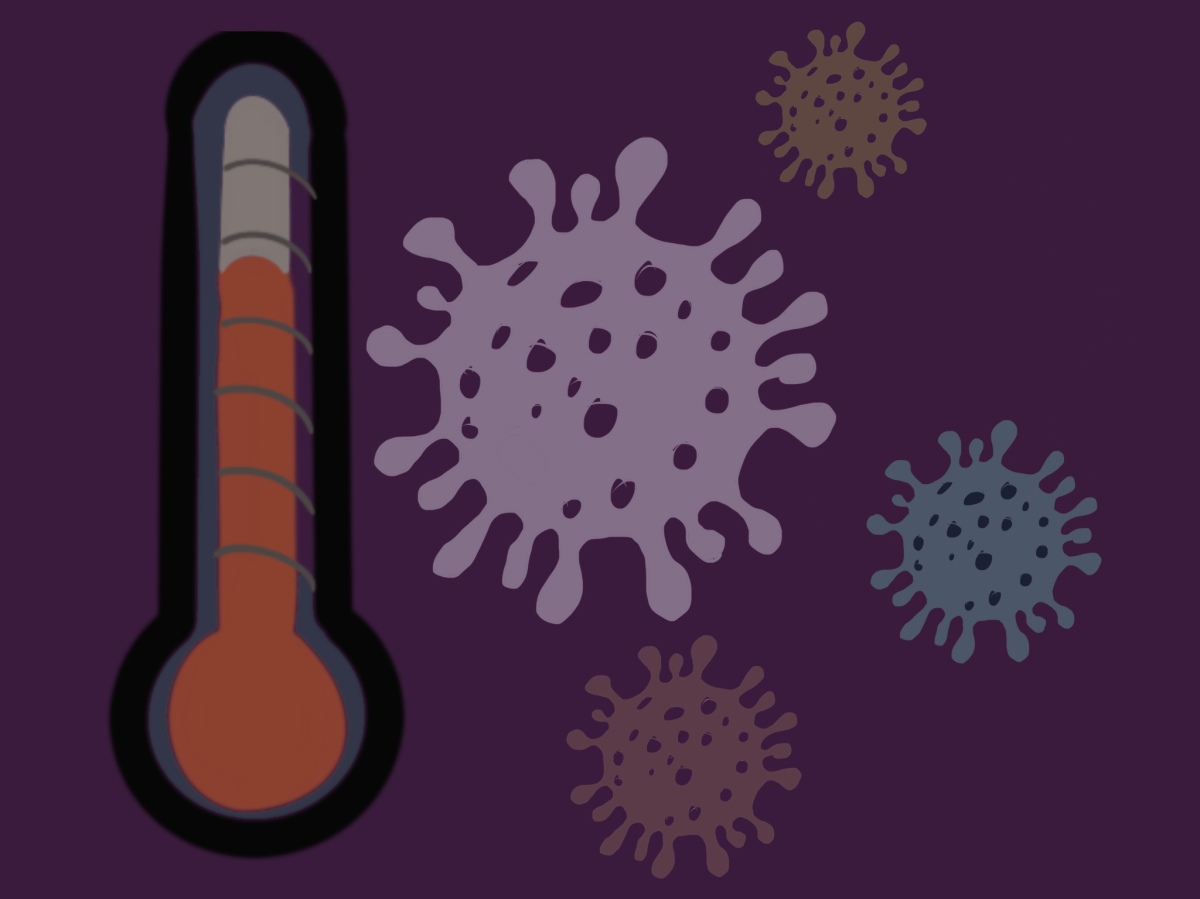A blog about mental health, emotional distress, autism and hope.
I feel like I am unravelling. Thoughts are like words outside my head. My body seems to be somewhere else. Where “I” end and everything else begins seems fuzzy, fluid, and fucked up.
Am I in pain? I don’t know.
Am I upset? Not sure.
What do I want and need? No idea – and please stop asking all those difficult questions!
I’ve had a tough few weeks that culminated in a car crash a fortnight ago. The hospital scans show that thankfully, I have no broken bones. My bruises reveal I am injured. My sensory processing indicates something is very, very wrong and I must prioritise self-care.
The one question I can answer is “Do I feel safe?”
My answer is a resounding “NO!”
My lived experience of mental illness, emotional distress and sensory processing differences, is one of fear, uncertainty and feeling very, very unsafe. As an autistic person, my experience of the world tends to be chaotic and unpredictable at the best of times and when I factor in traumatising events, illness and injury, the chaos goes up a level!
Sensory Processing
All of us experience the world through our senses. In addition to the five senses that are involved in processing sensory information coming into our bodies from outside: touch, taste, hearing, sight, and smell, we have three more sense systems: our proprioceptive, vestibular and interoceptive sense systems.
Our proprioceptive sense system is used to process where our body is in space and where our limbs are in relation to each other. Try this… Close your eyes, put one arm out straight in front of you with your thumb up. Then, keeping your eyes closed, reach out with your other hand and arm and grab that upright thumb. How you perform is based on your personal experience of proprioception in that moment.
Our vestibular sense system is used to process the effect of gravity on our body. Some of us love a rollercoaster, some of us feel queasy on a calm sea.
Our interoceptive system is used to process emotions. These emotions are grouped into homeostatic emotions which include tiredness, hunger, pain, needing the toilet, and our other internal states; and affective emotions which include anger, excitement, fear, joy and all those other feelings we experience.
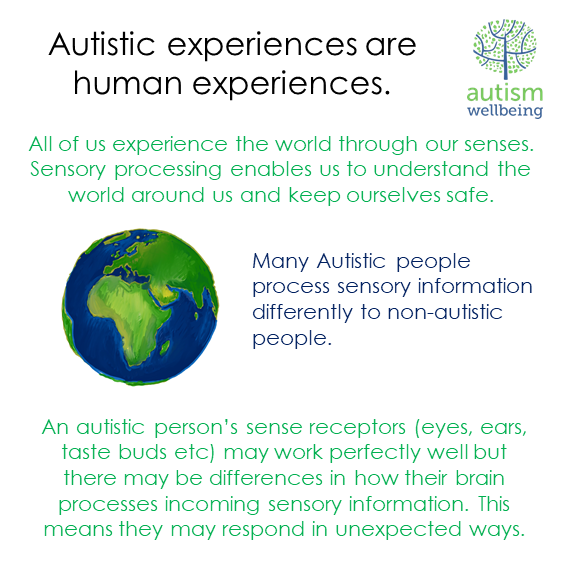
The way we experience sensory input depends on our unique sensory profile – those sensations we enjoy and seek out, and those we dislike or avoid. Autistic people tend to have sensory differences because although our sense receptors (eyes, ears, skin etc.) could be working fine, our brains frequently find there is too much or too little sensory information to register. This means we may experience sensory input in heightened or muted ways.
How we experience emotions will depend on how we experience interoceptive signals. For some of us, some of those interoceptive signals may be muted – perhaps we don’t notice we are hungry until we are so ravenous, we can’t stop eating. Or perhaps we might – like me – try and walk off a dislocated knee as it twinged a bit but surely couldn’t be anything serious! If we experience interoceptive signals in a heightened way, a small amount of pain may be unbearable or we may always feel like we need the toilet, even when we don’t physically need to go.
Like most autistic people, I tend to experience sensory input differently to non-autistic people. My personal sensory profile is typically one of muted proprioception and interoception, whereas my sense of hearing and smell are often heightened. But this varies, just as it does for all of us. If I have a lot going on, my muted proprioception gets even more muted and I’ll find myself bumping into doorways even more than I usually do. My hearing may get even more heightened and human speech pierces my ears with pain and vibrations that make me respond as if I am being tortured.
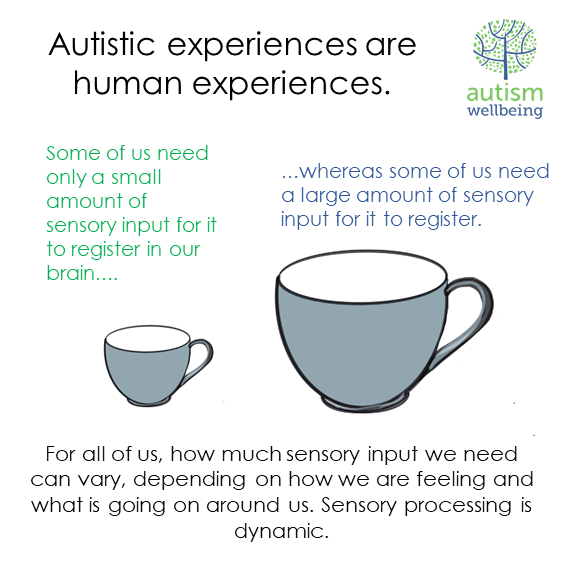
My personal sensory experiences are like most peoples (autistic or not) – variable – and dependent on how I feel, who I am with and what is going on around me. Sensory processing is dynamic. This may sometimes be misinterpreted as the autistic person over-reacting or deliberately being oppositional, especially when on one day they may tolerate a sensation e.g. the noise of the dishwasher being unloaded, but find it painful the next.
When my wellbeing is poor, when I am ill or stressed or already processing too much information, my sensory experiences become more extreme – even by my own standards. Unsurprisingly, the events of recent weeks have resulted in my brain having way too much to process, and my sensory processing experiences have let me know all about it!
How might this look?
Most people are probably unaware that our brains are constantly working away in the background, fine-tuning sensory information. We need a balance of sensory input to be at our best and to learn and take part in social interactions. This seems so obvious, it hardly needs saying, but for those of us who often find there is often too much or too little sensory information, life can be more difficult. Those of us who are autistic are likely to experience differences in how we process sensory information. In addition to experiencing heightened or muted sensations, our processing of sensory information may be distorted or delayed or fragmented. Some sensory information may perseverate or stick around repeating itself long after the event has passed.
Here are a few examples from my lived experience:
- People’s faces look distorted when I’m walking around a crowded shopping centre. Like their facial features are melting.
- I can still hear the school bell in my ears and feel the horrible sensation in my body at 6pm, even though it went off to signal the end of the school day at 3.30pm.
- Synaesthesia – I see musical chords as colours, and numbers as coloured shapes. Always.
- When I am very upset or have had a shock (e.g. the death of a family member), I don’t feel sad but my vision gets patchy and I can’t see my fingers when I am trying to use my phone. I might “feel” sad months later. This can be misinterpreted as me not letting things go – when in fact, I am only just feeling them.
- If I am overwhelmed, I feel seasick when walking and cannot bear to slow down, speed up, or change direction as I feel I may vomit.
- I hear “echoes” of previous conversations replaying out loud when I sit quietly.
- I cannot tell where my body ends because my proprioception is so muted. I may unknowingly invade other people’s personal space or fail to recognise my own body in the mirror.
- I hear my thoughts and they seem to become “out loud” rather than inside my head.
- I feel edgy, suspicious and on high alert.
- I want intense pressure, and even pain. My body craves intense and extreme physical input. This can be misunderstood as me being reckless.
When there is far too much or far too little sensory input to register with our brains, we become dysregulated.
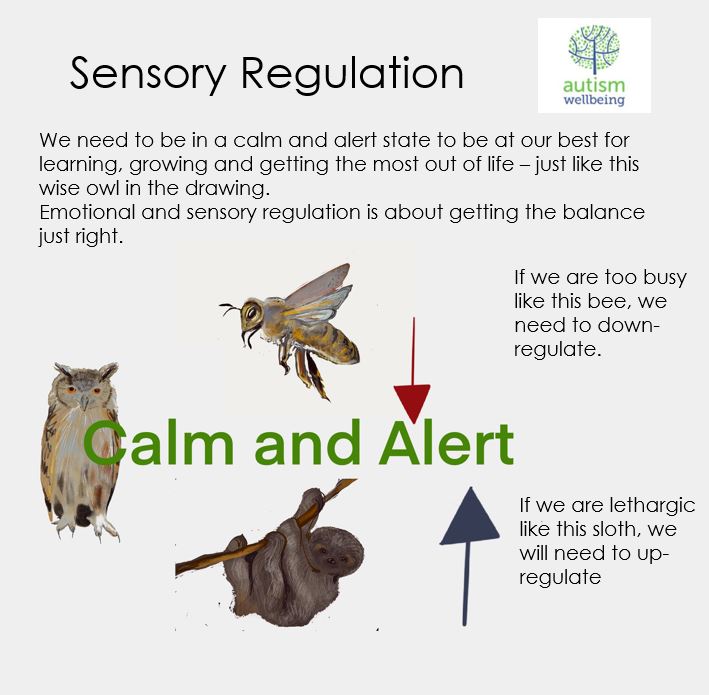
How we up and down regulate ourselves will depend on our own personal sensory profile – and whatever else is going on for us at the time. As an autistic person, I often find that there are fewer opportunities to regulate myself in daily life, due to my natural sensory differences. If I enter a busy shopping centre, my brain finds there is way too much of everything and I could easily become overwhelmed. If I instinctively regulate myself by stretching, or bouncing up and down, or by humming a noise that drowns out some of the unpredictable background noises, I may be at risk of being asked to leave due to my inappropriate behaviour. Read more about this in my blog ‘ Autistic traits: when self-care gets pathologised ‘.
Sensory or Psychosis?
Some of the descriptions of my lived experience may sound like hallucinations or symptoms of psychosis, and for many years my undiagnosed autism was treated as mental illness.
Things get tricky when we try and unpick what is going on for autistic people who are distressed. It is known that autistic people are more likely to experience mental illness than our non-autistic peers. It hardly seems surprising when the world we experience is often more painful and extreme due to our sensory processing differences. It is also unsurprising when we consider how our lived experience is often invalidated with comments about us “overreacting” to things other people aren’t even aware of.
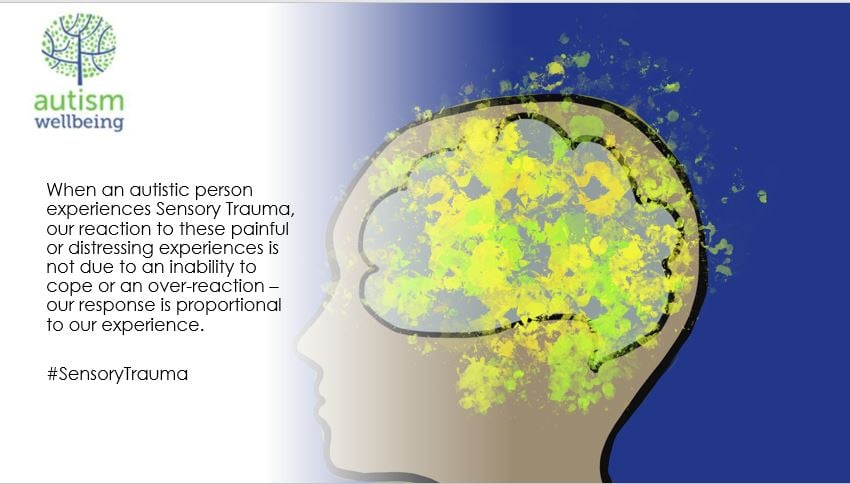
If we have seen ourselves as mentally ill and our sensory experiences as symptoms of psychosis then we may perceive ourselves to be deteriorating or experiencing a relapse when we are experiencing sensory overload. Of course, autistic people can be mentally ill and experience relapses and those of us who have support in place to manage those times should always seek input from the people we trust to help us with our wellbeing. My story of mental illness was one of feeling like I lacked resilience and couldn’t cope, because when the going got tough, my senses got going! For me, an increase in sensory processing disturbances would usually result in an increase in antipsychotic medication. However, whilst medication dampened down some of my distressing sensory experiences, it also dampened my joy.
For anyone reading this who is beginning to question their own mental health and medication, I urge you to talk things through with someone else before considering changing your treatment. I did gradually change my treatment, but only once I had found a reliable way of managing my wellbeing effectively. I still use medication for my mental health, but I am also incredibly proactive in keeping myself regulated.
Managing urges to self-harm
Self-harm was a daily part of my life for many years. It is not something I have done for a long time and it is thankfully, something I rarely crave anymore. There are times where the urge is still there, but I no longer feel bad about having those urges. It is unsurprising that I have cravings when it was my “go to” for so long in the past. Just like any other craving or urge, I use it as cue to give my body what it needs.
If I feel thirsty, I use it as a cue to have a drink. I have the choice as to whether that drink is a cup of tea, a glass of water, or 5 pints of beer!
If my legs feel restless, I use it as a cue to go for a walk. I might have a gentle stroll, a 5 mile hike, or a jog round the block.
If I feel tired, I might have an early night – or I might not! The choice is mine.
Sensory processing is what we use to identify what is going on within and around us – and how we respond to it.
When I feel the urge to harm myself, I use it as a cue to increase my proprioceptive input. Proprioception is my “go to” sense when I am craving intense physical input. Proprioceptive input helps us feel safe – that’s why we might enjoy a hug, or squishing our body into a tight space, or wearing snug fitting clothes or doing up our shoes extra-tight so we get a good sense of where our body is. Clinicians often hypothesise over why people self-harm. They quote people as “managing intense emotions” or “a cry for help” or “punishing themselves”. These may well be factors and like many human experiences, there is rarely a single explanation, but no-one has ever described self-harm to me as being due to “needing a big dose of proprioceptive input to make me feel safer”. But for me, and many of the people I have supported in my professional career, some of our self-harm is a very human, very natural craving for proprioceptive input – which makes a lot of sense when you consider our sensory differences.
Proprioception comes from the Latin meaning ‘to know oneself’. That is exactly what this sense does. It gives us a sense of where our body is and where our limbs are in relation to each other.
The proprioceptive signals are sent from our muscle spindles, ligaments and joints up to the brain to be processed. For many of us who are autistic these signals can be ‘weaker’ or ‘blurry’ which can leave us feeling like we have an unclear sense of where our body is.
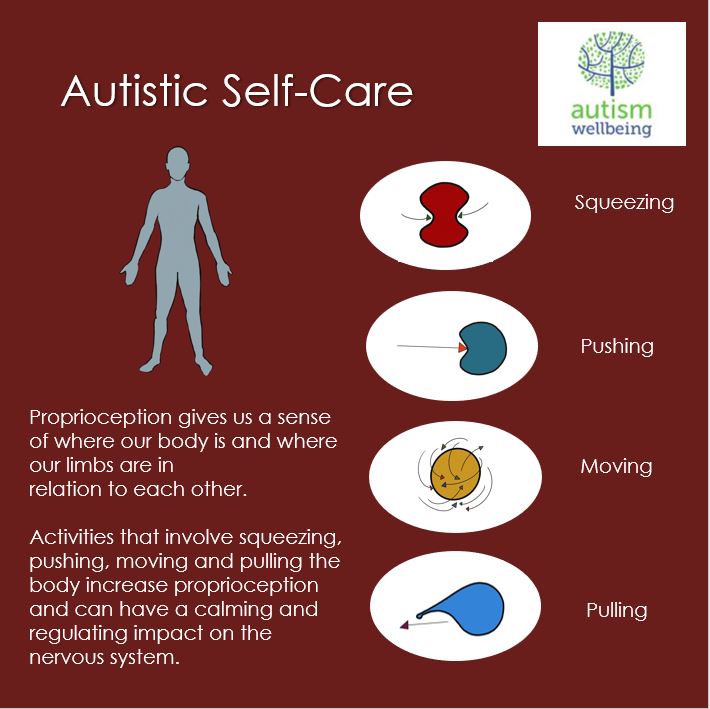
Humans are complex and our coping mechanisms are complex. Understanding how we respond to distressing situations, whether sensory or otherwise, requires us to be nuanced in our considerations, and a short blog like this one is not able to unpack this level of complexity. My aim was to share how my own responses to distressing life experiences are always impacted by my autism and sensory differences. Identifying which experiences are mental health symptoms and which are not, isn’t always relevant. Being able to regulate myself is what is important. Being regulated helps with wellbeing, whatever the cause of the distress.
Proactive regulation
Proactive Regulation is a term Autism Wellbeing UK uses to describe how we can make sure we regulate our senses and emotions throughout the day so that we can function at our best.
For us, this might include wearing headphones in a busy shop, or carrying a scented inhaler tube to smell to help us feel grounded.
Proactive regulation also means showing ourselves self-compassion where possible, by avoiding or delaying activities that are likely to dysregulate us rather than pushing on regardless. Turning the habit of self-harm into a habit of self-compassion has been as time- and energy-consuming as making or breaking any other habit. BUT…
It has got easier the more I have done it. At first it was about “doing” rather than “feeling”. My brain and body craved intensity and pain and I had to push that to one side while I was compassionate towards myself. At first it felt unnatural, clunky, ridiculous and fake!

Me doing my self-care when it was new to me!!!
Mostly, when I feel distressed these days, I automatically see it as a cue to do some self-care, show myself compassion, and regulate myself. I even feel able to reach out to others that I trust. Here are some infographics about proactive regulation. It is important to be regulated before you need to be, in fact you can stockpile regulating sensory input for later. Just as I described feeling the distressing effects of the school bell hours later, or hearing “echoes” of previous conversations in my quiet moments, I can feel the positive effects of regulating input hours later too. Proactive regulation has been a game changer for me.
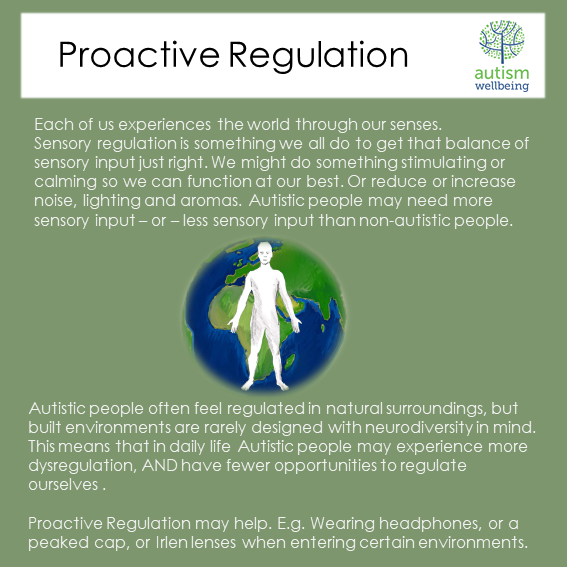
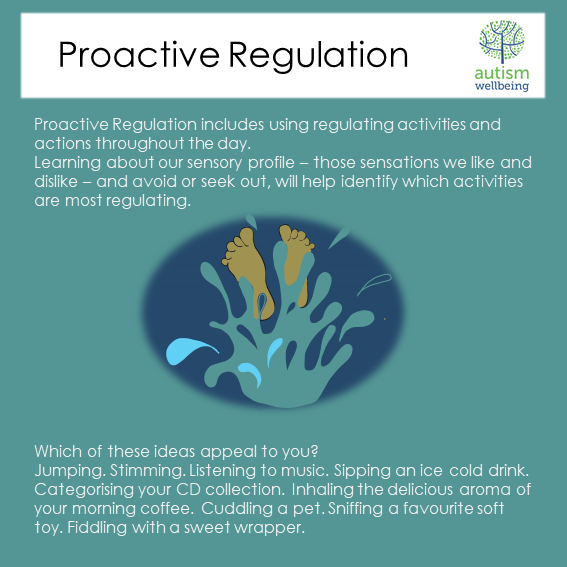
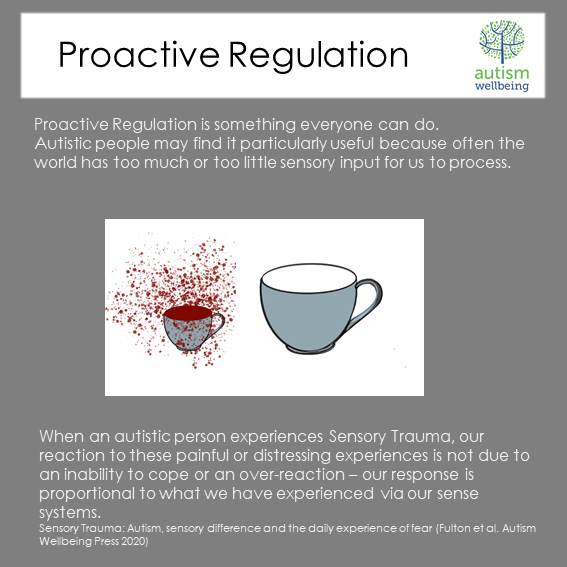
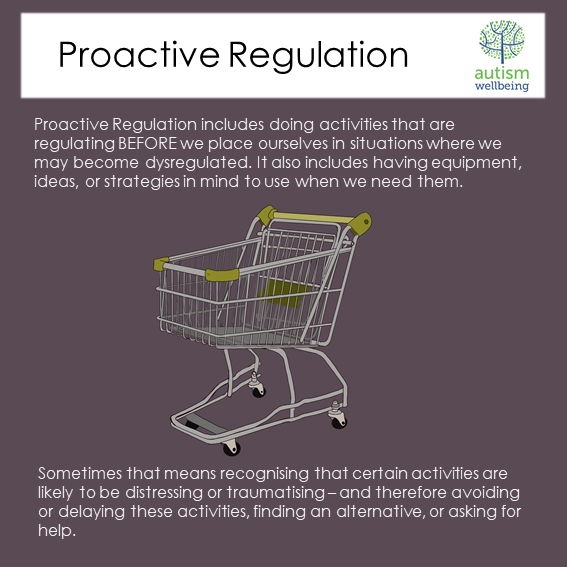
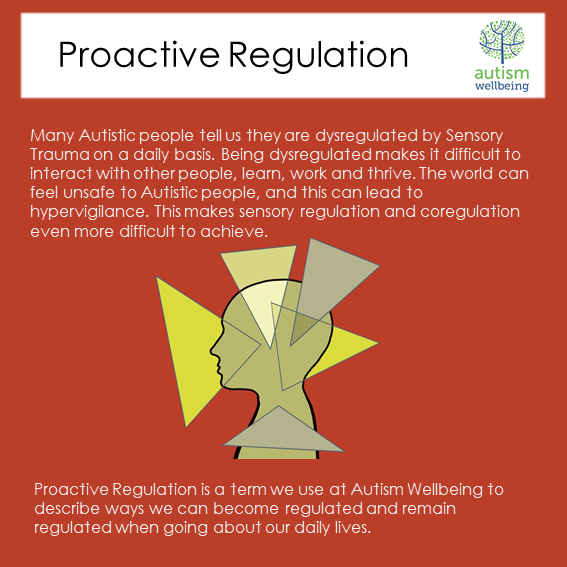
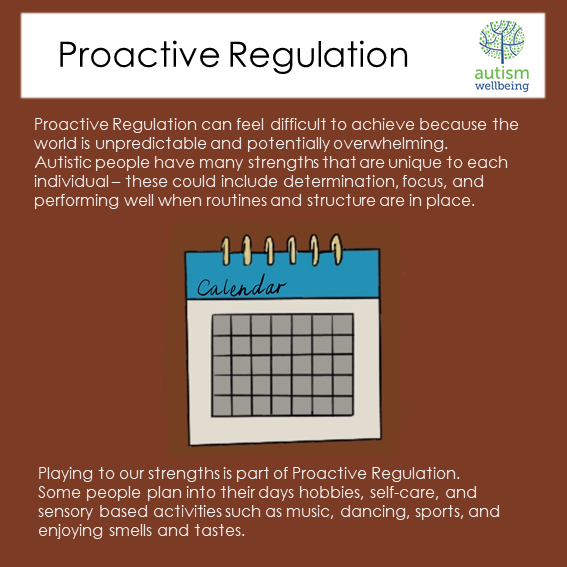
Thank you for reading this blog. I was unsure about whether to add trigger warnings as what triggers each of us may be different. Even trigger warnings can be triggering! This blog is one of positive change and hope. If you need help with difficult and distressing feelings raised by this blog, please reach out to someone or contact the Samaritans or other organisations.


